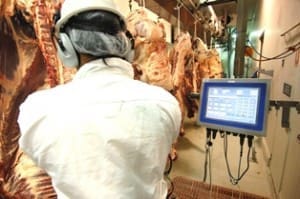THE mini-rally in meatworks grid pricing that started last week has continued, with advances totalling 20c/kg ($66 on a typical 330kg grassfed export steer) now recorded in many Queensland processor offers since late June.
 It’s reflecting the gradual tightening in slaughter cattle supply as the year wears on, and some improvement in processor profitability compared with the first quarter of the year, aided also by a softer Australian dollar.
It’s reflecting the gradual tightening in slaughter cattle supply as the year wears on, and some improvement in processor profitability compared with the first quarter of the year, aided also by a softer Australian dollar.
Best offers as of this morning from competitive southeast Queensland processors were 425c/kg for heavy cows and 490c/kg for four tooth grassfed ox. Plants a little further inland with a freight advantage were offering around 415c for cows and 480c for steer. Central Queensland pricing is typically 10c/kg behind those rates.
A northern NSW export processor has offers circulating this week for kills this current week of 490c/kg on four-tooth grassfed ox, and 415c/kg on heavier cows.
NSW grids generally last week only rose a few cents, while Victorian grids rose from 3-11c/kg, depending on the category, suggesting supply is now running short. Grainfed export bullock money this week ranged from 525c to 530c on a spot price for current kills, and 535-540c for forward contracts for slaughter mid-October, when slaughter numbers are likely to be very scarce.
Latest market rises appear to be more about protecting market share and an acceptable rate of kill, rather than any underlying processor optimism.
One processor spoken to this morning thinks that while quality may be compromised, numbers will continue to flow for some time, while ever it stays as dry as it is.
“More suppliers are now setting staged deadlines – if it does not rain by this date, I sell these cattle; and if it does not rain by this date, I sell these cattle,” he said.
“Until there is a clearly-defined break in the season, I think we will just continue to see this sell-down, which should help underpin supply,” he said.
“They may be lacking weight and lighter in condition, but I’d now say in the absence of rain that there will be a modest supply of cattle right through the next couple of months,” another processor contact said.
Frosts this past week across areas of the Darling Downs pushed a yarding above 12,000 head for today’s Roma store sale, but quality appeared to be mixed, and offering fewer prospects for slaughter.
The opposite scenario – 75 to 100mm of rain across large parts of eastern Australia – would see cattle supply dry-up almost overnight. Whether cattle prices can react to that as much as some producers might hope will be influenced somewhat by record high grain prices, and an increasingly competitive trading environment in the largest Japanese export market, where growing volume of beef out of the US continues to challenge Australian supplies. The US recorded a huge weekly kill around 667,000 head the week before last, pointing to sustained competitive pressure in markets like Japan and Korea for the foreseeable future.
US beef exports to all markets reached almost 118,000t last month (Australia: 101,00t), representing the sixth largest monthly volume on record. Year-to-date, US exports are up 10pc, year-on-year.
While a 1.5c rise in the value of the A$ over the past week has taken some of the gloss of processor returns, several export processors told Beef Central this week that they continued to trade in the black on current steer and cow pricing, despite this month’s rises in procurement cost. Margin might have declined $20-$30 a head on steer and cow, compared with figures from a month or six weeks ago, one processor said.
“There’s a margin in it that we are defending, both at the buy and sell end, but at the end of the day we don’t want the lights out, either. We’re trying to keep people in jobs,” he said.
Kills ease 1pc
Reflecting the broader supply trend, eastern states weekly kill for the week ended Friday closed at 143,572 head, down another 1pc on the week before, but still 9pc higher than this time last year.
Queensland’s kill last week reached 77,790 head, unchanged on the week before, but 9pc higher than last year.
The NSW female kill remain high last week, at 54.3pc of the total, suggesting female reduction is still occurring. The total NSW kill reached 33,300 head, down 3pc on the week before, while the Victorian tally of 23,639 head was down 3pc. In South Australia, numbers dropped 1pc to 3852 head, while Tasmania processed 4914 head, unchanged from the previous week.
